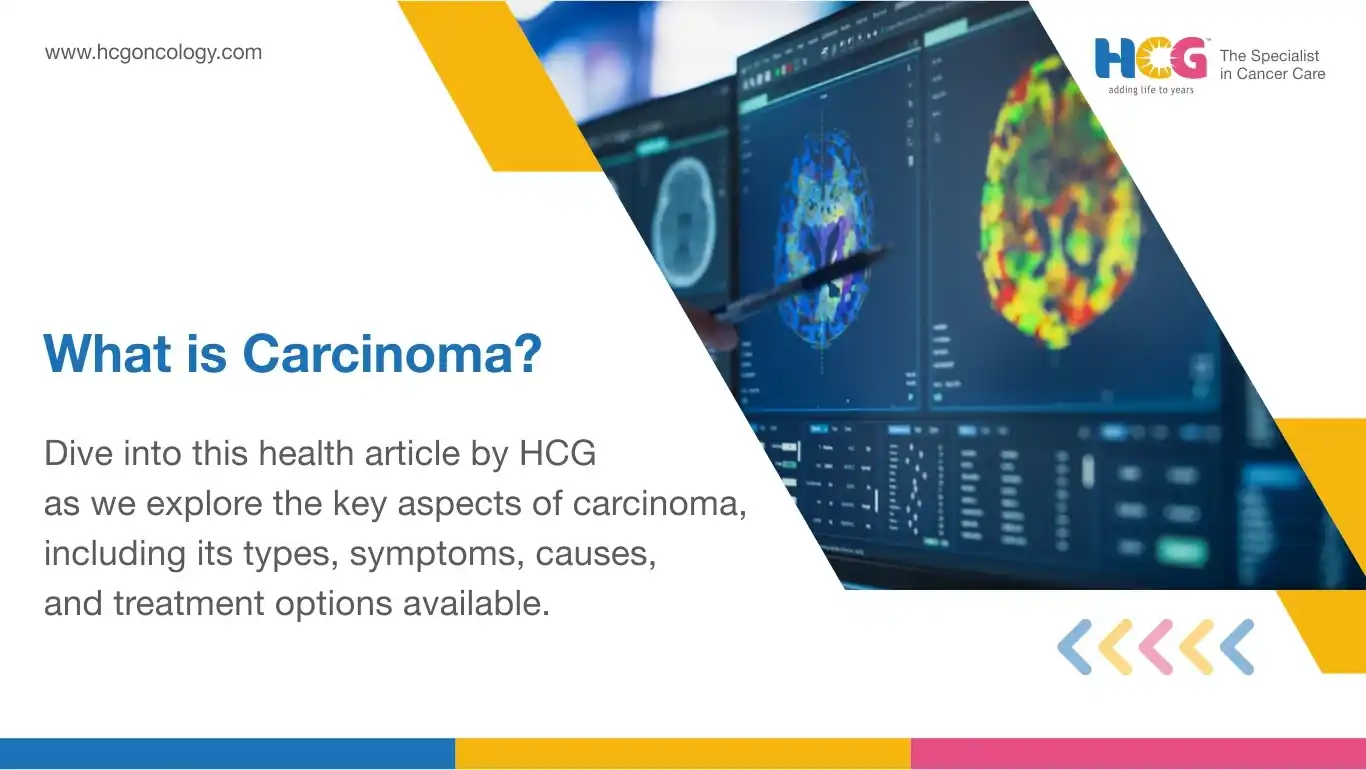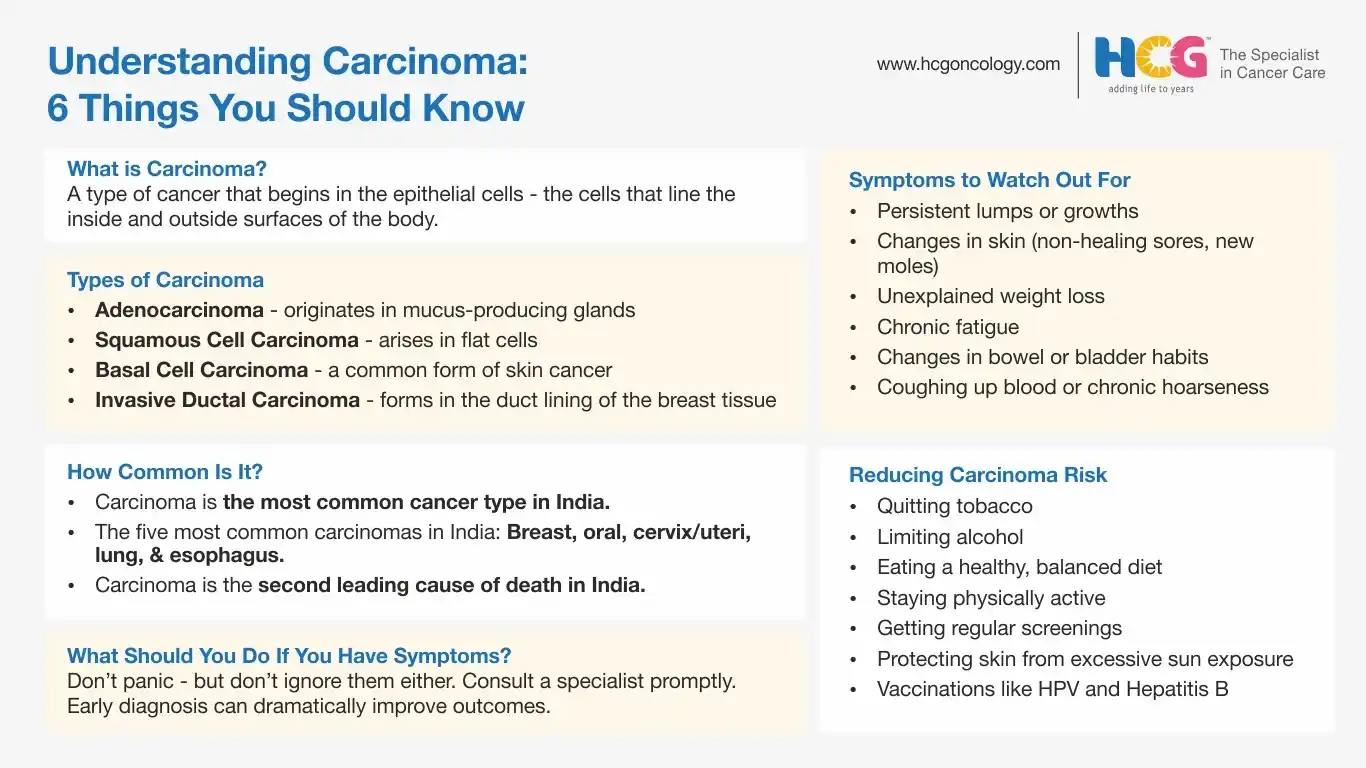
02 Dec, 2025
Feel free to reach out to us.

02 Dec, 2025

This article is medically reviewed by Dr. Sunit Lokwani, Consultant - Medical Oncology and Clinical Hematology, HCG Cancer Centre, Indore.
Carcinoma is the most common type of cancer, accounting for 80% to 90% of cancer diagnoses. Carcinomas may spread to other body parts or be confined to the primary location.
Carcinoma cancer begins in the skin's epithelial tissue or the tissue that lines internal organs, such as the liver or kidneys.
Generally, people think of cancer in terms of where it forms (breast cancer, colon cancer, etc.), but this is just one way to distinguish types of cancer in the human body. Scientists also classify cancers based on the type of tissue where cancer cells start growing.
Cancer classifications by tissue type include carcinoma, sarcoma, myeloma, leukemia, and lymphoma.
While carcinoma is prevalent, sarcoma is rare; the key difference between carcinoma and sarcoma lies in the type of tissue where the cancer begins.

Carcinoma is categorized into various types based on the cell type from which they originate and the extent of disease spread.
Some common types of carcinoma are basal cell carcinoma, renal cell carcinoma, adenocarcinoma, squamous cell carcinoma, invasive ductal carcinoma, and ductal carcinoma in situ.
Basal cell carcinoma is the most common type of skin cancer. The cancerous cells grow in the skin's basal cell layer, or the epidermis's lowest part. Usually, basal cell carcinomas grow slowly and rarely spread, or metastasize, to nearby lymph nodes or more distant parts of the body.
Adenocarcinoma typically develops in the mucous membranes of glands or organs. These cells make and secrete, or release, important fluids in the body, such as digestive juices and mucus.
Some common types of adenocarcinoma are lung cancer, breast cancer, pancreatic cancer, and colon cancer.
Squamous cell carcinoma is often known as the second most common type of skin cancer. It develops from the flat, squamous cells that are the primary cell type making up the outermost layer of the skin, the epidermis.
Squamous cell carcinomas are more likely than basal cell carcinomas to invade fatty tissue beneath the skin or to spread even further.
Invasive ductal carcinoma develops when cancerous cells grow in the duct lining of breast tissue, break through the wall of the duct, and invade local breast tissue. From there, the cancer may spread, or metastasize, to other parts of the body.
Ductal carcinoma in situ is the most common type of breast cancer. Cancerous cells are confined to the lining of the milk ducts and usually don’t spread through the duct walls into surrounding breast tissue.
Invasive carcinomas refer to the type of carcinoma that has spread beyond the primary tissue layer to the surrounding tissue. The term "infiltrating carcinoma" is also used synonymously for these cancers.
When carcinoma has spread to other tissues and organs, it’s known as metastatic carcinoma.
Although the terms are often confused, metastatic carcinoma is different from metastatic cancer because not all cancers are carcinomas.
Carcinoma in situ refers to the carcinoma type that's confined to the layer of tissue from which it started and that hasn't spread to surrounding tissue or other parts of the body.
The term "in situ cancer" or "stage 0 cancer" is used to describe this early form of carcinoma.
Carcinoma has been more commonly linked to these lifestyle factors and conditions. The following are some of the possible causes of carcinoma.
The following are some of the commonly observed carcinoma symptoms.
Carcinoma is diagnosed using a combination of methods to detect, locate, and confirm the presence of cancerous cells.
Here are some common methods for the diagnosis of carcinoma.
If a patient is experiencing symptoms or the results of a screening test suggest cancer, the doctor will carry out a physical examination and assess the medical history of the patient and their family.
The doctor may recommend additional tests for a conclusive diagnosis.
Blood tests for cancer detection look for signs like abnormal cell counts or tumor markers; however, they can't confirm the cancer itself.
Scans like X-rays, CT scans, MRIs, or ultrasounds help diagnose carcinoma, determine tumor size and its exact location, and check if the cancer has spread.
A biopsy involves collecting a small portion of the tissue from the suspected area and examining it under a microscope to confirm the presence of cancer.
It is considered the only definitive way to diagnose carcinoma.
Treatment for carcinoma varies depending on the type, location, and extent of the disease. Here are some of the commonly recommended carcinoma treatment options:
Carcinoma may be treated with surgery, which involves the surgical removal of the tumor tissue with a small portion of healthy tissue surrounding it.
Minimally invasive surgical treatment methods, such as robotic surgery, laparoscopic surgery, and endoscopic surgery, may help reduce healing time and reduce the risk of infection after surgery.
Radiation therapy is one of the most common carcinoma treatments. It is often used in combination with surgery and/or chemotherapy.
Advanced radiation therapies use image guidance before and during treatment to target tumors and are designed to help spare healthy tissues and surrounding organs.
Chemotherapy is also considered one of the most common carcinoma treatments. It involves using drugs designed to destroy cancer cells, either throughout the whole body or in a specific area.
In some cases, chemotherapy may be used in combination with other cancer or carcinoma treatments, such as radiation therapy or surgery.
Immunotherapy helps your immune system identify cancer cells and eliminate them. The doctor may recommend immunotherapy alongside other treatments, like chemotherapy.
Hormone therapy focuses on slowing or stopping the growth of cancer cells by altering the production or functioning of the hormones responsible for cancer growth.
For example, long-term exposure to estrogen has been linked to breast cancer risk. Exposure to androgens has been linked to prostate cancer. Hormone therapy for these cancers alters the production of these hormones to control cancer growth.
As a carcinoma treatment, targeted therapy uses drugs that target specific proteins present on the cancer cells or genetic changes in cancer cells. Targeted therapy can zero in on those specific molecules or genetic changes and kill the cancer cells or stop them from multiplying.
In conclusion, carcinoma is a common type of cancer, making up 80-90% of cancer diagnoses. It arises from the epithelial tissue in various parts of the body. The term “carcinoma" refers to a cancer that develops in the cells lining the organs and skin.
Understanding sarcoma vs. carcinoma highlights the key difference between carcinoma and sarcoma, where these cancers start. While carcinoma arises in epithelial cells, sarcoma originates in connective tissues like bone and muscle.
The carcinoma treatment options are diverse, ranging from surgery and radiation to more advanced therapies like immunotherapy, hormone therapy, and targeted therapy. Early diagnosis through methods like biopsy, blood tests, physical exams, and imaging can help guide the best treatment plan.

Dr. Sunit Lokwani
Consultant - Medical Oncology And Clinical Haematology
MBBS, MD (General Medicine), DM (Medical Oncology)
Dr. Sunit Lokwani is an accomplished medical oncology and clinical hematology consultant who specializes in treating and managing different types of cancer through systemic treatment approaches. He is available for consultations at HCG Cancer Centre, a leading cancer hospital in Indore. He is a certified intensivist from the Indian Society of Critical Care Medicine (ISCCM) and the Chinese University of Hong Kong (CUHK), along with DM Certification by IDF.
Before HCG, he was associated with several prestigious healthcare institutes, including Kokilaben Hospitals (Indore), Shalby Hospitals (Jabalpur), Vydehi Institute of Medical Sciences and Research Centre (Bangalore), and CMC (Vellore), among many others.
Appointment Link: Book an Appointment with Dr. Sunit Lokwani.